Urban Green Cover and Built-up Analysis for Melbourne-region | I Hug Trees
Half yearly Analysis of City Vegetation for Melbourne-region, tracking vegetation health and urban development trends from satellite data. This digest integrates NDVI and NDBI indices, highlights zones of vegetation stress versus built-up surfaces, and assesses urban heat island effect with heat-risk mapping and 3D visualizations.
Published on: 2025-10-13

This preview, captured by the Sentinel-2 satellite from its orbit at approximately 786 km above Earth, shows the Melbourne region in striking detail. Urban greenness and built-up patterns across Melbourne, from Newport in the west to East Melbourne and the Bayside in the east, spanning the southern suburbs up to the northern CBD. Imagery observed on 2025-09-18 .
Info Box for Awareness
Why this matters
At I Hug Trees we turn science into awareness so that we understand how humanity's effort and nature's wonders shape the living balance of our green spaces. The green patches around the globe vanish and recover telling us a story of resilience and renewal. Is it not? As we aim to bring scientific credibility into our numbers and maps we help everyone see what connects us all.
Understanding NDVI and NDBI
Satellites like Sentinel-2 capture sunlight reflected from the Earth in many narrow colour ranges, called spectral bands. Plants and trees reflect more light in the near-infrared band and absorb more in the red band, that’s how NDVI helps us see how green or healthy an area is. NDBI uses other bands to highlight built-up areas, showing how vegetation and development change side by side. Together, they help us understand the story of our landscapes, where green spaces thrive and where it needs care.
Methodology
NDVI (Normalized Difference Vegetation Index) values were derived from Sentinel-2 imagery using red (B04) and near-infrared (B08) bands. Cloud masks were applied using QA60 flags. Images were processed at 10 m resolution through the Microsoft Planetary Computer API. Monthly NDVI averages are compared over time to assess vegetation trends and greenness changes. Note: Some summary insights in this analysis were generated with the help of AI tools. All satellite data and numerical outputs are based on verified Sentinel-2 observations.
Data integrity & processing note
All datasets are processed using open satellite imagery from the Microsoft Planetary Computer and verified with consistent parameters such as cloud cover, resolution, and band alignment. Each NDVI and NDBI image is generated using reproducible Python workflows to maintain scientific credibility.Data processing and map generation were performed using AWS cloud infrastructure.
Current Scenario — Melbourne-region
Melbourne’s landscape offers a strong contrast to many other cities. It's a mix of planned green corridors, urban parks, and fast-growing suburbs. While the city continues to expand outward, efforts in tree canopy programs and sustainable planning have helped preserve much of its green character. Satellite data shows consistent vegetation cover in its outer zones, but inner districts still face gradual decline due to dense construction. These insights remind us how policy, community action, and climate awareness together shape a city’s living balance.
NDVI
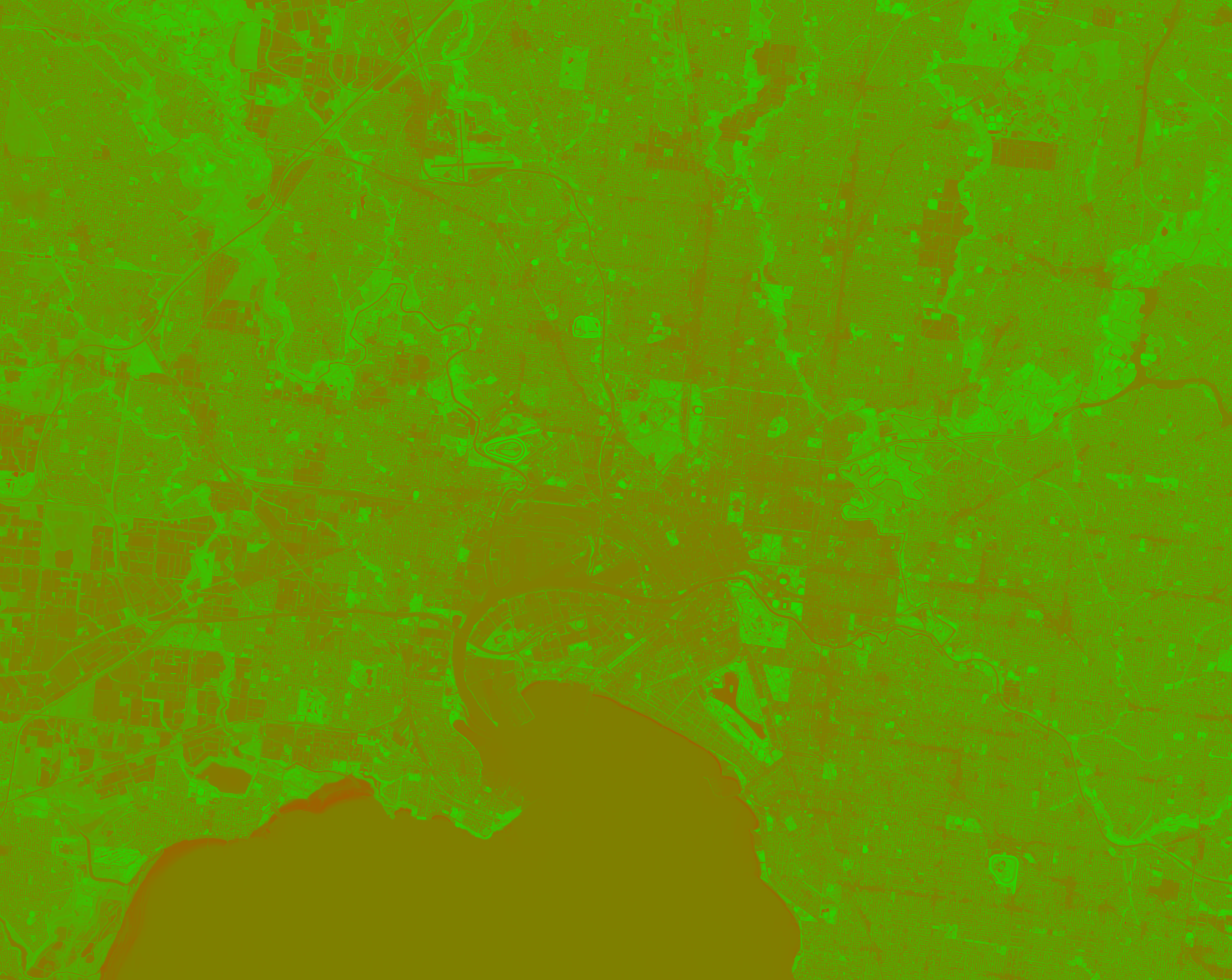
NDVI — color visualization

NDVI — greyscale (index values)
NDVI csv values
| min | max | mean | median | stddev |
|---|---|---|---|---|
| -0.5853399038314819 | 0.7309518456459045 | 0.1887800097465515 | 0.18179884552955627 | 0.145381897687912 |
NDBI (Built-up Index)

NDBI — color visualization
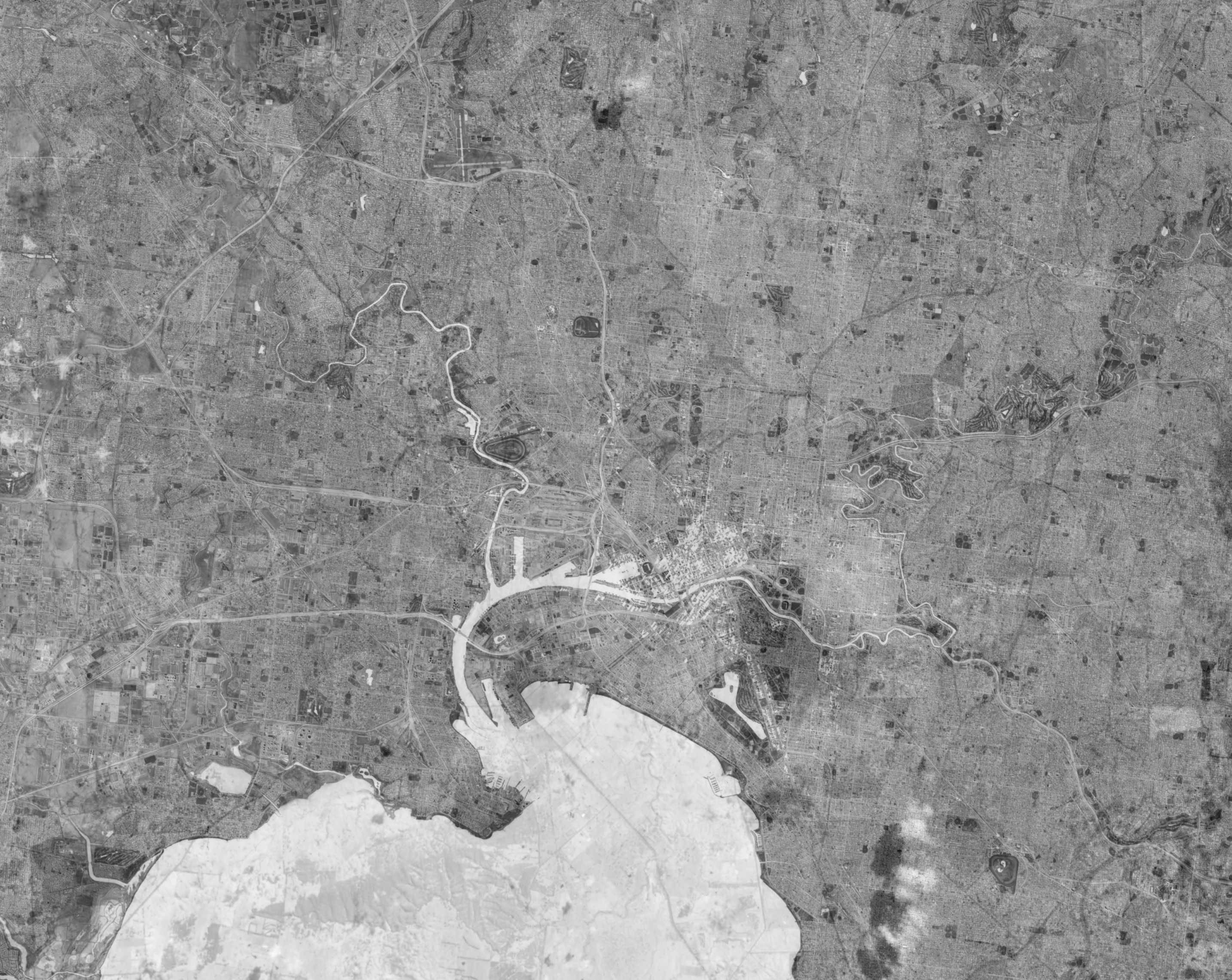
NDBI — greyscale (index values)
NDBI csv values
| min | max | mean | median | stddev |
|---|---|---|---|---|
| -0.7728124856948853 | 0.7078508734703064 | 0.06897701323032379 | 0.04540229216217995 | 0.1893252432346344 |
NDVI − NDBI & Heat Risk
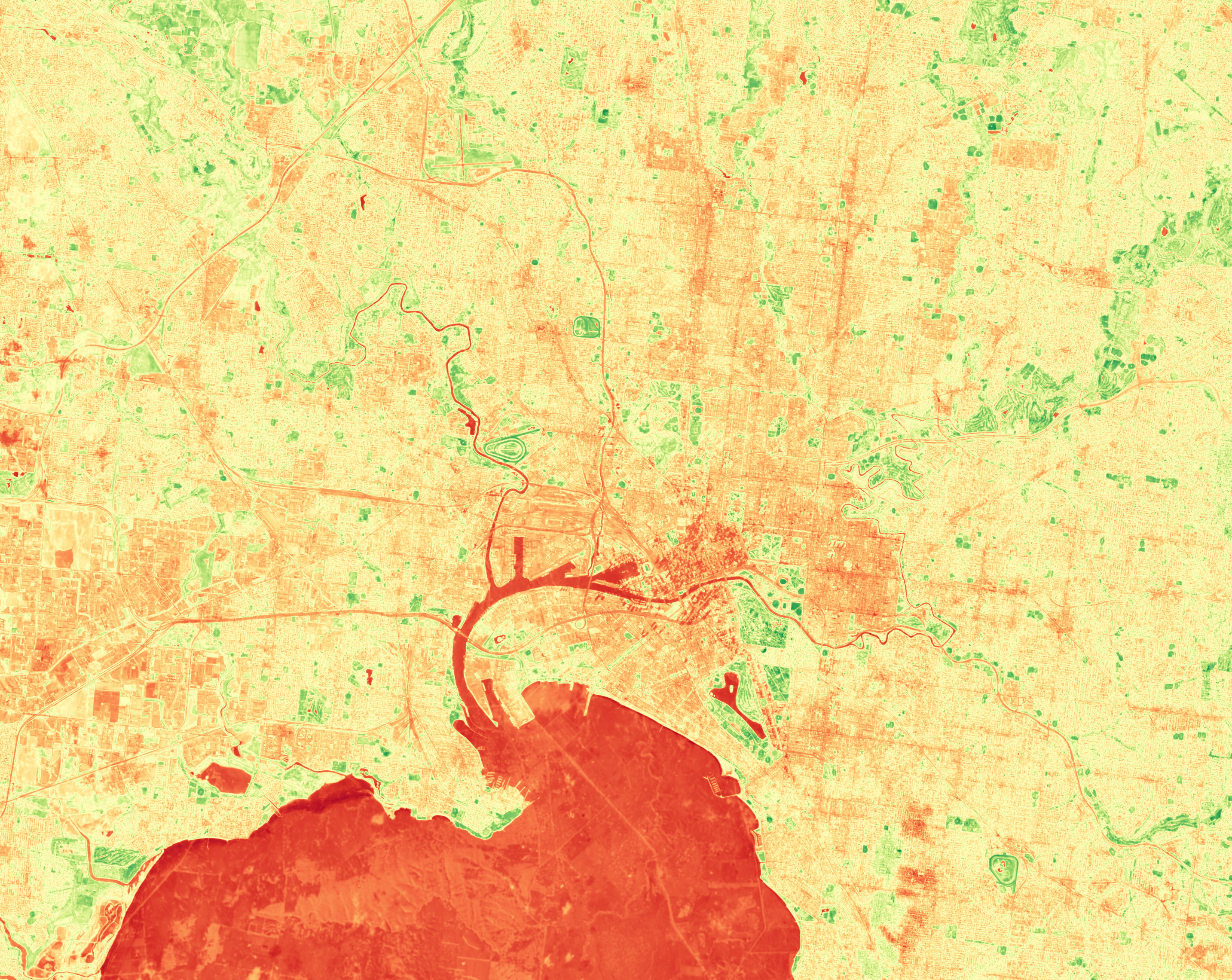
Difference visualization — highlights vegetation vs built-up dominance.
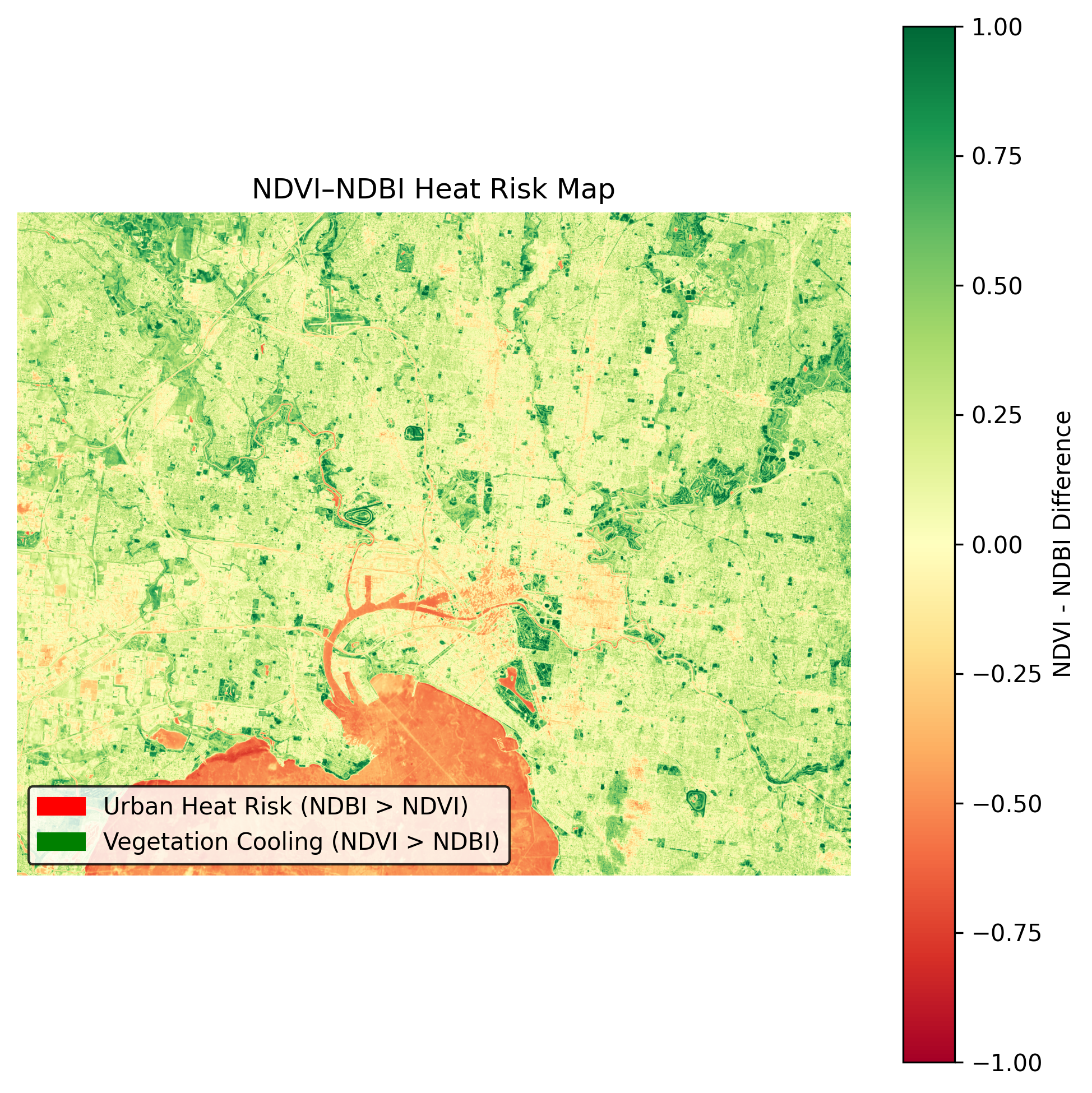
Heat risk interpretation derived from NDVI–NDBI difference.
- Focus on areas with low NDVI values for potential vegetation restoration.
- Monitor built-up hotspots indicated by high NDBI values for urban heat island mitigation.
- Enhance green corridors in regions where NDVI exceeds NDBI to maximize cooling effects.
3D Renders (Rayshader & Rayrender)
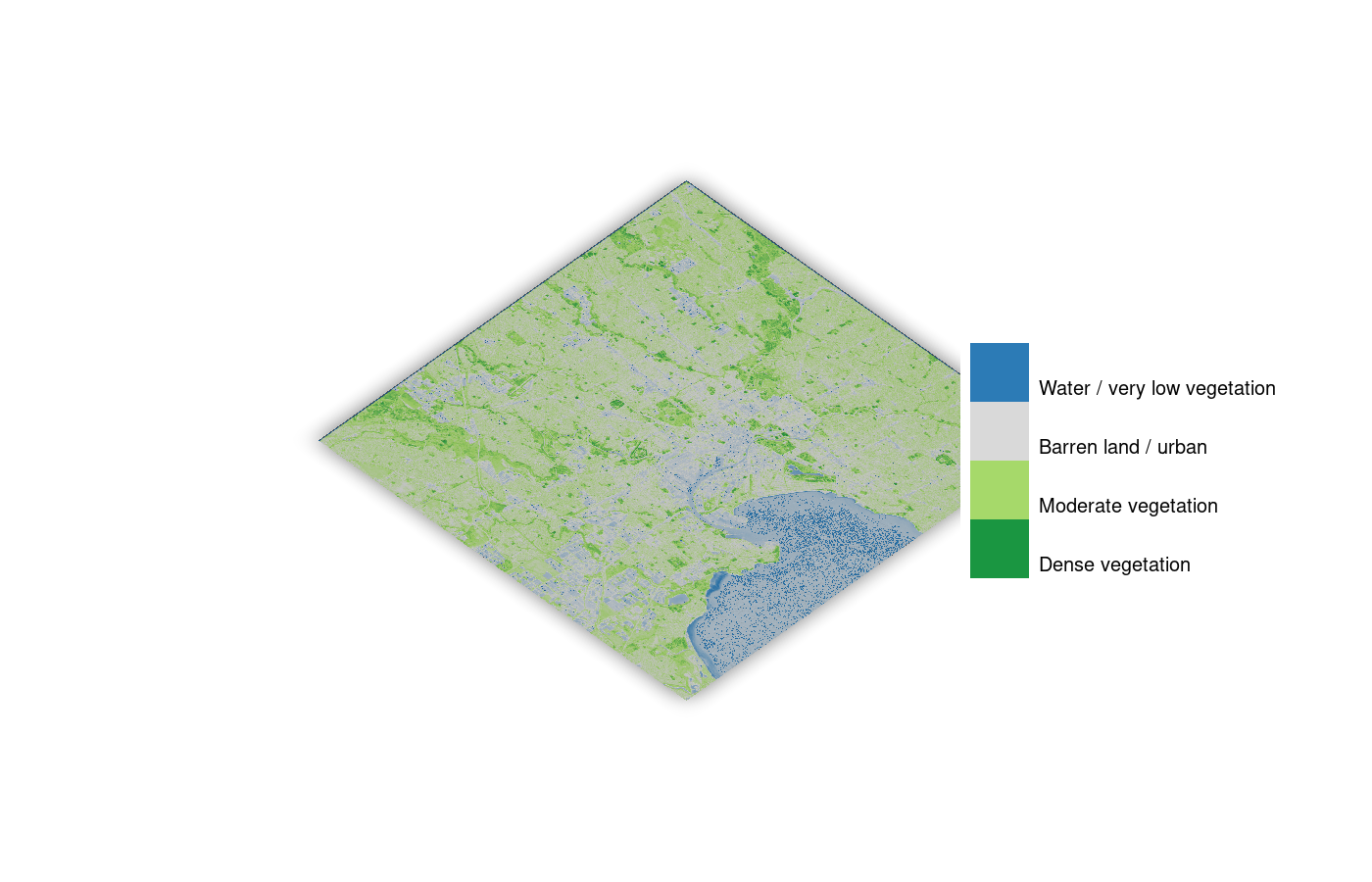
Rayshader 3D visualization derived from NDVI height-extrusion. Click on image for light-box effect
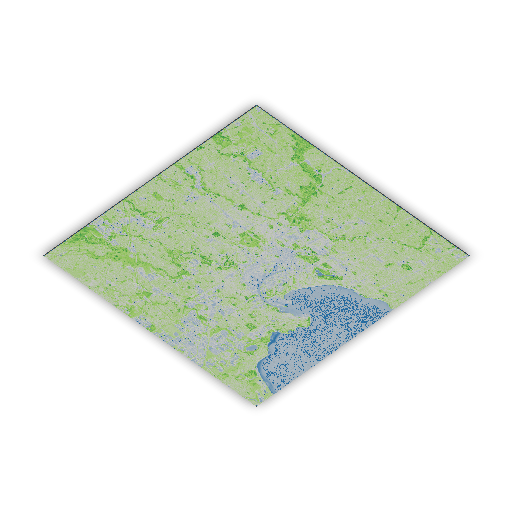
Rayrender 3D visualization derived from NDVI height-extrusion
Interactive NDVI overlay (zoom, pan, transparency). Use it alongside the static maps above.
Urban heat island effect
The analysis reveals that vegetation slightly predominates over built-up surfaces in the Melbourne region, offering a net cooling effect. However, areas with higher NDBI values indicate potential urban heat island effects, necessitating targeted interventions. We recommend a monthly monitoring cadence to track changes, prioritize vegetation restoration in low NDVI areas, and engage the community in urban greening initiatives.Disclaimer: this analysis refers to the satellite crop / geo-bounds stored under the 'Melbourne-region' folder (may include extended suburbs) and does not represent the full administrative limits of Melbourne.
Get involved
Every dataset, image, and map here is part of a bigger mission — to connect people with the science behind urban greenery. If this work inspires you, there are more ways to explore and participate:
- Read our Urban Forestry Daily Digest — a quick way to stay updated on global green space insights and local restoration efforts.
- Explore the latest Chennai, India NDVI Digest (latest update) to see how vegetation trends compare across regions.
- Visit our feature article Urban Forestry and Green Living to understand how urban forests improve our health, climate, and community life.
Join us in sharing awareness, supporting greener city planning, and bringing data-driven stories of hope to light. Email: nature@ihugtrees.org Have a place in mind you’d like us to study next? Share the city or region name where you’d love to see an NDVI and NDBI analysis.
Alternatively, send us an email directly. We review every suggestion to understand where green monitoring can create the most impact.References & Data
Free to Download (Please cite):
I Hug Trees NDVI Data Citation:
The NDVI and NDBI GeoTIFF and images are provided by I Hug Trees for scientific purposes. Please cite as:
@misc{ihugtrees_ndvi_2025,
author = {I Hug Trees},
title = {NDVI and NDBI Analysis Data - Chennai region 2025},
year = 2025,
note = {GeoTIFF and images provided for scientific purposes},
url = {https://ihugtrees.org}
}
Microsoft Planetary Computer Citation
If the Planetary Computer is useful for your work, please cite it using this record on Zenodo:
@software{microsoft_open_source_2022_7261897,
author = {Microsoft Open Source and
Matt McFarland and
Rob Emanuele and
Dan Morris and
Tom Augspurger},
title = {microsoft/PlanetaryComputer: October 2022},
month = oct,
year = 2022,
publisher = {Zenodo},
version = {2022.10.28},
doi = {10.5281/zenodo.7261897},
url = {https://doi.org/10.5281/zenodo.7261897}
}